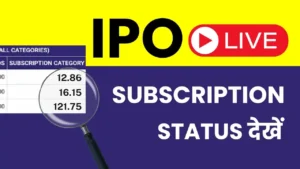IPO Subscription Status indicates the demand for an Initial Public Offering (IPO) based on the number of times it has been subscribed. Investors monitor this status to understand market interest in a company’s shares before they are listed on stock exchanges like NSE and BSE. The subscription status provides insights into whether an IPO is oversubscribed or undersubscribed, affecting the potential listing gains.
What is IPO Subscription Status?
An IPO subscription status shows how many times an IPO has been subscribed to on the NSE and BSE. This status is crucial as it reflects investor demand. If an IPO is heavily oversubscribed, it often indicates a strong market interest, leading to potential gains on listing. Conversely, an undersubscribed IPO might signal less enthusiasm or market uncertainty.
Live IPO Subscription Numbers are typically updated during the subscription period, allowing investors to track real-time data and adjust their investment strategies accordingly.
Types of IPO Investors and Categories
IPOs are open to different types of investors, categorized as follows:
- Qualified Institutional Buyers (QIB): This group includes financial institutions, banks, Foreign Institutional Investors (FIIs), and mutual funds. They often have the largest share of IPO allocations.
- Non-Institutional Investors (NII): This category includes individual investors, NRIs, companies, and trusts who invest more than ₹2 lakhs in an IPO.
- Retail Individual Investors (RII): Retail investors or NRIs investing up to ₹2 lakhs fall into this category. They are generally allotted a smaller portion of the total IPO shares.
- Employee (EMP) Category: This category is for employees of the company going public, often offered shares at a discounted rate.
Importance of IPO Subscription Status
The current IPO subscription status helps investors make informed decisions about applying for an IPO. High subscription numbers often suggest a promising IPO, potentially listing at a premium. Conversely, low subscription numbers might indicate limited interest or concerns about the company’s prospects.
Tracking IPO subscription updates is vital for gauging demand and setting expectations for the allocation process. An oversubscribed IPO leads to a lower chance of allotment per application, moving the allocation to a lottery system.
Live IPO Subscription Data
Below is a table showing the current IPO subscription status of some recent IPOs on NSE and BSE:
| IPO Name | QIB | NII | RII | Total |
|---|---|---|---|---|
| Paramatrix Technologies | – | 6.23 | 11.86 | 9.21 |
| Aeron Composite | 27.82 | 75.53 | 33.77 | 41.07 |
| ECOS Mobility | 136.85 | 71.17 | 19.66 | 64.18 |
| Travels & Rentals | – | 3.27 | 20.24 | 11.75 |
| Boss Packaging Solutions | – | 1.31 | 3.38 | 2.35 |
| Baazar Style Retail | 0.70 | 0.47 | 0.84 | 0.73 |
| Jeyyam Global Foods | 0.00 | 0.00 | 0.00 | 0.00 |
| Gala Precision Engineering | 0.00 | 0.00 | 0.00 | 0.00 |
| …and more |
For a comprehensive list of ongoing and closed IPO subscriptions, visit our IPO Subscription page.
Analyzing IPO Subscription Numbers
Oversubscription and Its Impact
When an IPO is oversubscribed, it means the demand for shares exceeds the number available. This scenario often leads to a higher listing price and increased interest from investors post-listing. For example, Rapid Multimodal Logistics closed with a total subscription of 350.50 times, indicating strong market enthusiasm.
Over-subscription can also influence the Grey Market Premium (GMP), a premium at which shares are traded in the grey market before being officially listed on exchanges. High GMP often indicates a positive market sentiment towards the IPO.
Under-subscription and Its Consequences
Conversely, under-subscription occurs when an IPO fails to attract enough investor interest to cover the available shares. This situation could signal a lack of confidence in the company’s prospects or unfavorable market conditions. Ola Electric, for instance, had a total subscription of just 4.45 times, suggesting tepid investor interest.
How to Check Live IPO Subscription Status
Investors can check the live IPO subscription numbers on platforms like Zerodha, Upstox, and Angel Broking. Here’s a quick guide:
- Zerodha: Visit the Zerodha console and navigate to the IPO section to view the subscription status.
- Upstox: Open the Upstox app, go to the IPO page, and check the live subscription data.
- Angel Broking: Log in to the Angel Broking app and find the IPO section to see real-time subscription numbers.
For detailed subscription data across different platforms, check our IPO Subscription Tips page.
Key Takeaways for Investors
- Monitor IPO Subscription Progress: Regularly check subscription numbers to understand demand. High numbers suggest potential listing gains, while low numbers may indicate risks.
- Understand Your Category: Know your investor category—QIB, NII, RII, or EMP—and the allocation criteria associated with it.
- Follow Real-Time Updates: Utilize platforms like Zerodha, Upstox, and Angel Broking for the most up-to-date subscription data.
- Stay Informed on Upcoming IPOs: Keeping an eye on upcoming IPOs helps investors plan their strategies. Check out our Upcoming IPOs page for the latest information.
IPO Subscription FAQs
1. What does IPO Subscription Status mean?
IPO Subscription Status reflects how many times an IPO is subscribed to compared to the shares offered. It helps investors gauge the demand and potential success of the IPO.
2. How is the IPO Subscription calculated?
If a company offers 100,000 shares and receives bids for 500,000, the IPO is considered subscribed 5 times. This over-subscription often leads to allotments via a lottery system.
3. Who are Qualified Institutional Buyers (QIB)?
QIBs are institutional investors like banks, mutual funds, and insurance companies. They usually have the largest share of the IPO allocation.
4. Who are Non-Institutional Investors (NII)?
NIIs are individual investors or entities investing more than ₹2 lakhs in an IPO. This group includes NRIs, companies, and trusts.
5. Who are Retail Individual Investors (RII)?
RIIs are individual investors or NRIs who invest up to ₹2 lakhs in an IPO. They often receive a smaller portion of the total shares.
6. What happens in the case of an IPO over-subscription?
In case of over-subscription, the allotment moves to a lottery system, and not all applicants receive shares. The chances of allotment decrease as the subscription rate increases.
7. What is the role of the Employee (EMP) category in IPOs?
The EMP category is reserved for employees of the company issuing the IPO. They often receive shares at a discounted rate.
For more FAQs and in-depth analysis, visit our IPO FAQ section.
Conclusion
Understanding IPO subscription status is essential for making informed investment decisions. By staying updated on the current IPO subscription status, investors can gauge market demand and make strategic choices. Be sure to follow our site for the latest updates and comprehensive coverage on IPOs.
For more detailed insights and updates on upcoming IPOs, Grey Market Premiums (GMP), and more, check our other sections:
Stay informed, stay ahead in your investment journey with our comprehensive IPO analysis and updates.



